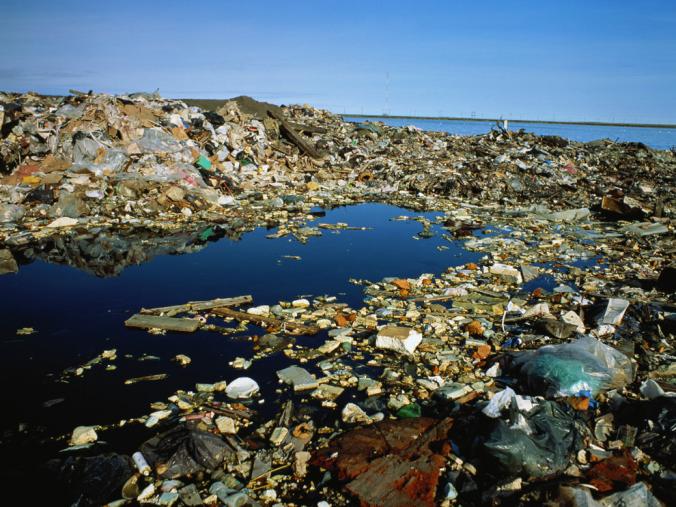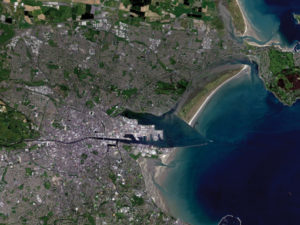
Prof. Hans-Peter Plag, PhD
Mitigation and Adaptation Research Institute
Old Dominion University Norfolk, Va.
www.mari-odu.org
Flows in the Earth’s Life-Support System (ELSS) were the subject of my last column. This column is about language and how flows and systems are represented in our language. We often use metaphors that are almost right, but then they are slightly wrong – and by being slightly wrong, they tend to provided a reflection of the real world that is significantly biased and misleading. We use words that misrepresent the system and disguise the causes and consequences. The mix of metaphors, words and underlying paradigms creates a reflection of the world that blurs the threats and hides obvious solutions from our view.
The “Greenhouse Effect” is a poor metaphor for what humanity’s effect is on the coupled ocean-atmosphere system and the global warming resulting from the massive changes in flows of energy and matter humans caused in the ELSS during the last few hundred years. Others have pointed out that the metaphor is weak because the heat-trapping mechanism in the climate system is different from that in a Greenhouse [1]. But the systems are different; for the coupled ocean-atmosphere system, the “Pool Effect” or the “Sauna Effect” would be better metaphors.
The glass roof of a greenhouse lets most of the radiation from the sun pass through, and it reduces the transport of heat back through the glass roof and the glass walls. It changes the balance of the energy flow in terms of what goes in and what comes out, and the difference results in a warming of the air inside the greenhouse. Without the glass roof and walls, the warmer air would expand and rise in a convective motion. In contrast, the walls and roof of the greenhouse prevent the warming air from escaping, and this effect leads to much warmer air inside of the greenhouse.
For the Earth, the imbalance of incoming and outgoing radiation is caused by heat-trapping gases (HTGs) in the atmosphere reducing at some frequencies the amount of infrared radiation emitted back into space. As detailed in the last column, humanityís interference with the chemistry of the atmosphere and the Earthís surface cover has increased this imbalance by a very large factor. But most of the additionally absorbed heat is stored in the ocean, not in the atmosphere, and that makes the system very different from a greenhouse.
Think of a deep swimming pool housed in a glass room. Most of the heat in this system will be stored in the pool water, not in the air above it. Warming the water to a temperature that is in equilibrium with the incoming radiation takes time, and the air temperature in the pool house will lag behind the equilibrium temperature for a long time until both water and air have reached a temperature that has incoming and outgoing radiation in a balance. With the large water body in the pool, the pool house can store far more additional heat than a greenhouse of comparable size. When night temperatures decrease, the water will radiate back some of the stored heat and keep the air above the pool warm throughout the night.
Moreover, evaporation will also lead to higher humidity, which allows more heat to be stored in the wet air than in dry air. And the warmer the air in the pool house, the more water it can hold: in fact, the amount of water that can be stored in air as water vapor before condensation happens depends on the air temperature to the power of three. Thus, if the air in the pool house was 10oC at the start, it could hold 9.4 g of water per m3. At 20o C, this amount increases to 17.3 g/m3, and at 30o C it is already at 30.4 g/m3. If we go all the way to 40oC, we can have 51.1 g/m3 of water vapor in the air.
A similar consideration applies to the coupled ocean-atmosphere system: As a result of the increased atmospheric contents of HTGs such as CO2 and methane, the incoming solar radiation not only warms the air, it also warms the ocean. In fact, the heat that can be stored in the ocean is much larger than what can be stored in the atmosphere. Estimates are that currently more than 90% of the additional heat absorbed by the ocean-atmosphere-land system goes into the ocean [2].
Similar to the pool house, the air temperature rises much slower than it would if there was no ocean. As a result, the warming of the atmosphere lags considerably behind the equilibrium temperature the system eventually will reach for the current level of atmospheric CO2 and other HTGs. This time lag will continue to exist as long as emissions continue to change the atmospheric contents of HTGs. As a consequence, future global warming will be much larger than the global warming we experience and can measure today.
The impact of ocean warming on evaporation is also comparable to what happens in the pool house. The warmer ocean evaporates more water, and the warmer air can store much more water before condensation and precipitation happen. The water vapor holds latent heat ñ that is, energy that becomes available again when the water vapor condensates. This energy is available for dynamics and can drive storms. The warmer the air, the more latent heat it can hold and the more can be made available for storms once condensation is triggered.
Thus global warming is all about flows. These include the flow of solar energy into the atmosphere-oceans system and storage of heat mainly in the ocean, the flow of water in the ocean currents that distributes energy throughout the ocean, the flow of energy in the form of latent heat carried by water vapor from the oceans to the atmosphere, the transformation of latent heat into kinetic energy when the water vapor condenses, and the flow of air in storms. These heat-filled storms can bring devastation to human communities.
This full picture of flows is poorly captured by the term “Greenhouse Effect.” The fact that we have oceans that can store more energy by far than the atmosphere should change global warming from a “Greenhouse Effect” to a “Pool Effect” with respect to energy storage and the exchange of energy between water and air. The large amount of additional energy stored in the ocean can be exchanged with the atmosphere and this changes the dynamics of the weather and climate systems profoundly, similar to a sauna, where heat is transported in the form of water vapor. The combination of the “Pool Effect” and “Sauna Effect” produces high-energy flows with many unpleasant side effects for the ELSS and humanity.
“The water vapor holds latent heat – that is, energy that becomes available again when the water vapor condensates. This energy is available for dynamics and can drive storms. The warmer the air, the more latent heat it can hold and the more can be made available for storms once condensation is triggered.“
Words can change behavior and impact ethics. Our growth-based, addicted economy requires a constant flow of products from producers to consumers – consumers of everything. By nature, we don’t seem to be consumers, but rather users. In past societies of scarcity, people were “consumers” of food but “users” of almost everything else. Tools, cloth, housing all were cherished, carefully maintained and often passed on from generations to generations. Flows of products were kept at a very low level. But our modern economy is focused on the creation of human wealth by accelerating flows as much as possible, and for that, people had to be transformed from users into consumers of everything: cloth, cars, furniture, houses, etc.

FIGURE 1A

FIGURE 1A. large fow of humans and material for the built environ-ment into the coastal zone has created a threat for the ELSS that will create large-scale pollution when the fow of water inundates the urban coasts as a result of sea-level rise.
In all areas, products are made today in a way that it is easier to consume them in a short interval instead of using them for a long time. Maintenance is often ineffective and repairing them is not possible. The rapid advance of technology also requires products to change long before the end of their lifetime and those still fully useable have to be replaced to accommodate new technologies. Even getting our food often forces us to consume large amounts of packaging, including a lot of plastic.
Again, everything is about flow: the flow of resources to the producers, the products to the consumers, the waste back to the environment, and the money from the consumers to the producers. By accepting to be denoted as “consumers” we are supporting a system that is accelerating the flows in the ELSS, changing it, and putting it under enormous stress.
Humans operate with the paradigm that we can live whereever we decide to live and do not need to adapt to potentially changing environmental conditions. The human species builds its dens (towns and cities) with great effort but without considerations of reasonable conditions and potential future environmental trajectories. Cities are built in high-temperature deserts, in areas with little access to food and water, and in hazardous places.
In particular, cities are rapidly sprawling in coastal areas with extremely flat topography directly exposed to the rising seas. A growing fraction of the global population is moving into these cities, ignoring the threats of rising seas for short-term benefits. The hazard for the ELSS is not the rising sea; the hazard is a species that ignores all available knowledge and foresight about possible future sea levels and continues business-as-usual.
The rapid flow of people and materials for the built environment into the coastal zone created a growing threat to the ELSS, and when water flows into these areas as a result of the rising seas, it will reverse the flow of people and change the character of the cities inland. However, most of the built environment will be left behind and cause large-scale chemical, biological and material pollution. The large amount of plastics used in modern buildings add to an already urgent problem: plastic pollution of the ELSS and particularly the ocean.
Humans have a tendency to adopt solutions for a specific problem without fully analyzing the consequences these solutions might have now or in the future for the ELSS. An important example is plastic. Plastic has provided apparent solutions for many problems, and today plastic is almost everywhere and in every product produced by humans. The consumption versus usage rate is very high and increasing. Less than 10% of the plastic produced is used more than once, and this high flow of plastic through the human system and into the ELSS has created a mountain of plastic distributed throughout the ELSS.
If current trends continue, by 2050 the ocean will contain more plastic than fish by weight [3]. And plastic has an enormous lifetime. It virtually never decays. It breaks down in small particles and these micro-particles are now in almost all flows in the ELSS [4]. They are dangerous because they absorb and concentrate chemical pollutants and increasingly contaminate many food chains. More and more animals, particularly in the marine environment, have contaminated micro-particles in their digestive systems.
Our plastic-based solutions create flows of plastic that are degrading the ELSS and may prove disastrous for many animals and ecosystems. If we’d apply our normative ethics to an analysis of the impacts of plastic on the ELSS, the result would be that the current consumption of plastic is highly unethical. Instead of acknowledging our responsibility, we construct chains of arguments to reason that economic growth depends on us consuming more and more plastic.
Finally, letís look at the language we use in our dialog about major threats. The threat of climate change is a good example. Those who use imagination to explore possible futures under climate change often are accused of describing “Doomsday Scenarios.” By choosing this word, an open-minded dialog about the spectrum of possible futures is no longer possible. Recently, David Wallace-Wells in the article ìThe Uninhabitable Earthî painted a dire picture of a possible future as a result of the most pessimistic climate scenarios [5], and instead of engaging in a serious dialog of this and other possible futures, a number of scientists immediately attacked him for describing a ìDoomsday Scenarioî not based on scientific evidence. They claimed he was scaring people away from doing something to address the challenge[6].

Figure 2: Since 1950, humanity has produced more than 9 billion tons of plastic and about 80% of this has been ejected into the ELSS. Much of this accumulates in the ocean in the form of contaminated micro-particles.
The list of events and processes that could lead to global catastrophes in the near future is long and indicates a rather precarious situation for humanity and our civilization. For example, there is increasing evidence that we are in the middle of the 6th mass extinction [7], which in the end might eliminate humans, too. But instead of developing language and a dialog that allow us to realize the full extent of the challenges, we increasingly listen to fake language that creates a virtual reality disconnected from the real world.
While scientific evidence is crucial for this dialog, there is also need for imagination in developing a broad spectrum of possible futures. Investigations should include scenarios that are not, or not yet, underpinned by current scientific evidence but cannot be excluded based on the knowledge we have. We should not inhibit the flow of thoughts about the dire futures we might encounter if we donít make a global and unparalleled effort to reduce the human-caused flows in the ELSS.
ENDNOTES:
1. Serendipity – Applying systems thinking to computing, climate and sustainability, 2015. Who coined the term ìGreenhouse Effectî? Available at http://www.easterbrook.ca/steve/2015/08/who-first-coined-the-term-greenhouse-effect/. Accessed on June 7, 2017.
2. Laffoley, D., Baxter, J. M. (eds.), 2016. Explaining Ocean Warming: Causes, scale, effects and consequences. International Union for Conservation of Nature and Natural Resources. Available at https://portals.iucn.org/library/node/46254. Accessed on August 3, 2017.
3. Plastic Pollution Coalition, 2017. See http://www.plasticpollutioncoalition.org. Accessed on August 1, 2017.
4. Geyer, R., Jambeck, J. R., Kara Lavender Law, K. L., 2017. Production, use, and fate of all plastics ever made. Science Advances, 3(7), DOI: 10.1126/sciadv.1700782
5. Wallace-Wells, D., 2017. The Uninhabitable Earth. New York Magazine, July 9, 2017. http://www.nymag.com/daily/intelligencer/2017/07/climate-change-earth-too-hot-for -humans.html.
6. Heinberg, R., 2017. Are we doomed? Letís have a conversation. http://www.postcarbon.org/are-we-doomed-lets-have -a-conversation. Accessed on July 31, 2017.
7. Barnosky, A. D. et al., 2011. Has the Earth’s sixth mass extinction already arrived? Nature, 471, 51-57. http://dx.doi.org/10.1038/nature09678.



